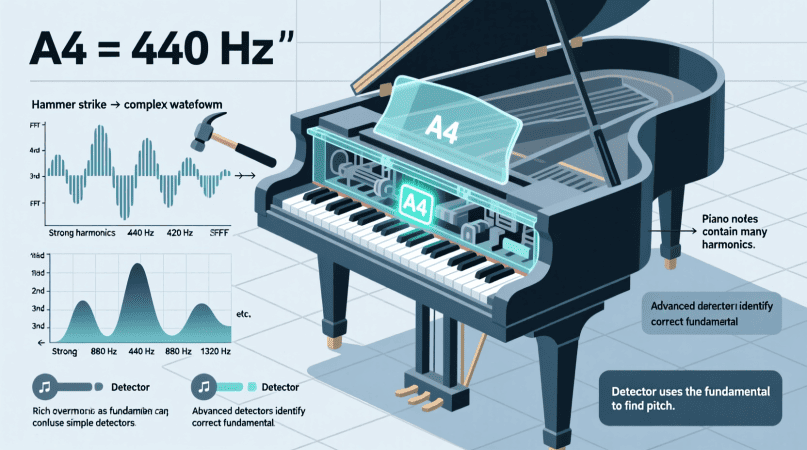
A piano can sound dull or harsh if even a few notes drift out of tune. Professional tuners train their ears for years, but beginners can take their first steps into tuning with the help of pitch detection tools.
These tools give you instant feedback on whether a note is sharp, flat, or aligned with standard tuning (A440). While they don’t replace a technician for full tunings, they’re a powerful way to learn the basics and maintain your instrument between visits.
Why Pitch Accuracy Matters on Piano
- Better sound quality: Chords ring clearly when notes are tuned correctly.
- Ear training: Detecting small pitch shifts strengthens your musicianship.
- Instrument health: Regular checks reduce stress on strings and frame.
- Confidence: You’ll know exactly where your piano stands instead of guessing.
What Is Pitch Detection in Piano Tuning?
Pitch detection measures the frequency of a note you play and shows you how close it is to the target pitch. Instead of relying only on your ear, you get a visual readout that confirms accuracy.
👉 Try checking middle A with the Voice Pitch Analyzer to see if your piano is aligned with 440 Hz, the global tuning standard.
Step-by-Step: Tuning Basics With Pitch Detection
1. Warm Up the Piano
Play for 5–10 minutes to stabilize string tension before checking pitch.
2. Start With Middle A (A4)
Play A4 and see if it matches 440 Hz. Adjust gently if you have tuning tools.
3. Work Outward With Octaves
Once A4 is set, move to A3 and A5. Use the detector to confirm octave alignment.
👉 The Singing Pitch Detector can display real-time shifts, which helps when playing intervals and chords.
4. Check Fifths and Intervals
Play simple intervals like C–G and D–A. Use pitch detection to see if both notes settle correctly without clashing.
5. Track Progress Across the Keyboard
Keep a log of which notes drift over time. This builds awareness of your piano’s tendencies.
👉 For longer checks, the Real-Time Pitch Detection tool helps monitor tuning stability across multiple octaves and chords.
Common Beginner Questions
- Do digital pianos need tuning? No—digital keyboards are always in tune, but pitch detection can help check settings or transpositions.
- How often should I tune an acoustic piano? At least once or twice a year, more often if it’s played daily or in changing climates.
- Can pitch detection replace a professional tuner? Not fully. It’s great for learning, ear training, and spot-checking, but full tunings are complex.
- What if my piano sounds right but the detector says otherwise? Trust both. Use the detector to confirm, but also listen carefully—your ear is the final judge.
Pro Tips for Using Pitch Detection
- Quiet environment: Background noise can throw off readings.
- Always tune up: Loosen slightly if you go sharp, then raise back to pitch.
- Log your results: Note which keys drift most often.
- Combine ear + detector: Use your ear first, then confirm visually for faster learning.
Try Our: frequency to note converter
Pitch Detector is a project by Ornella, blending audio engineering and web technology to deliver precise, real-time pitch detection through your browser. Designed for musicians, producers, and learners who want fast, accurate tuning without installing any software.
